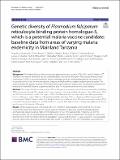| dc.description.abstract | Background
The limited efficacy of the two recently approved malaria vaccines, RTS,S/AS01 and R21/Matrix- M™, highlights the need for alternative vaccine candidate genes. Plasmodium falciparum Reticulocyte Binding Protein Homologue 5 (Pfrh5) is a promising malaria vaccine candidate, given its limited polymorphism, its essential role in parasite survival, a lack of immune selection pressure and higher efficacy against multiple parasites strains. This study evaluated the genetic diversity of Pfrh5 gene among parasites from regions with varying malaria transmission intensities in Mainland Tanzania, to generate baseline data for this potential malaria vaccine candidate.
Methods
This study utilized secondary data of 697 whole-genome sequences which were generated by the MalariaGEN Community Network. The samples which were sequenced to generated the data were collected between 2010 and 2015 from five districts within five regions of Mainland Tanzania, with varying endemicities (Morogoro-urban district in Morogoro region, Muheza in Tanga, Kigoma-Ujiji in Kigoma, Muleba in Kagera, and Nachingwea district in Lindi region). Wright's fixation index (FST), Wright’s inbreeding coefficient (Fws), Principal component analysis (PCA), nucleotide diversity (π), haplotype network, haplotype diversity (Hd), Tajima's D, and Linkage disequilibrium (LD) were used to assess the diversity of the gene.
Results
Of the sequences used in this study, 84.5% (n = 589/697) passed quality control and 313 (53.1%) were monoclonal (contained infections from a single strain of P. falciparum) and were used for haplotype diversity and haplotype network analysis. High within-host diversity (Fws < 0.95) was reported in Kigoma-Ujiji (60.7%), Morogoro-urban (53.1%), and Nachingwea (50.8%), while Muleba (53.9%) and Muheza (61.6%) had low within-host diversity (Fws ≥ 0.95). PCA did not show any population structure and the mean FST value was 0.015. Low nucleotide diversity values were observed across the study sites (mean π = 0.00056). A total of 27 haplotypes were observed among the 313 monoclonal samples and under-fives exhibited higher haplotype counts. The Pf3D7 was detected as Hap_1, which occurred in 16/313 (5.1%) monoclonal sequences. Negative Tajima's D values were observed among the parasite populations in all the study sites.
Conclusion
Low levels of polymorphism in the pfrh5 gene were observed based on low nucleotide and haplotype diversity, a lack of population structure and negative Tajima’s D values. This study provides essential data on the diversity of the Pfrh5 gene indicating that it can be considered in the development of the next generation malaria vaccines. Robust and intensive studies of this and other candidate genes are crucial to support the prioritization of the Pfrh5 gene for potential inclusion in a broadly cross-protective malaria vaccine | en_US |

